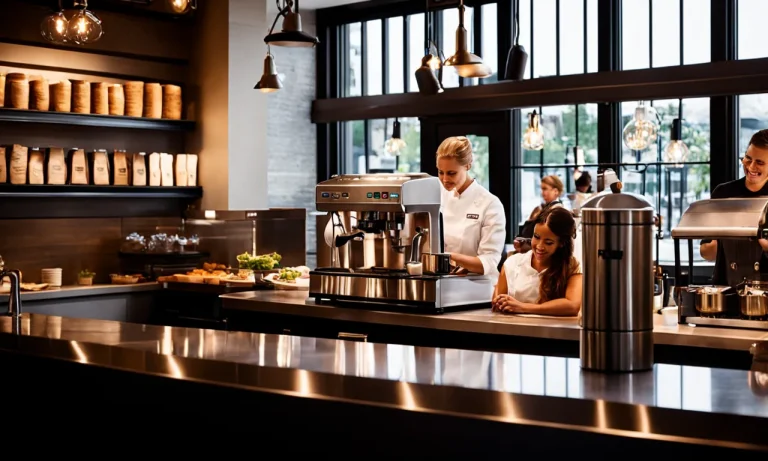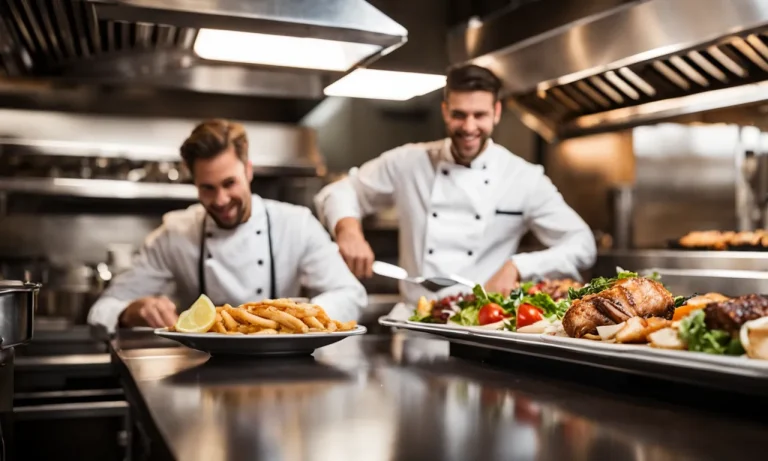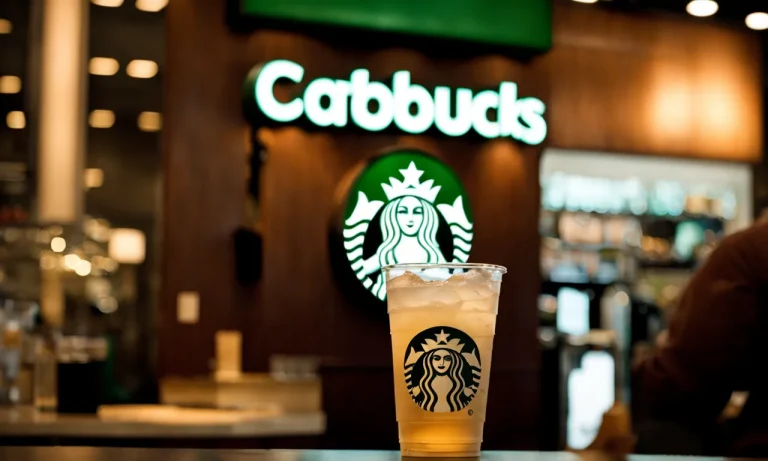Fusion cuisine is all the rage these days. More and more restaurants are experimenting with combining diverse flavors from different cultures and traditions to create inventive culinary mashups. But what exactly is a fusion restaurant?
In this comprehensive guide, we’ll explore what defines fusion cuisine, trace its origins, look at popular fusion food trends, and highlight some of the world’s most famous fusion restaurants.
If you’re short on time, here’s a quick answer: A fusion restaurant is a restaurant that combines and blends culinary traditions, ingredients, cooking techniques and flavors from different cultures and geographies into new, inventive and hybridized dishes.
Defining Fusion Cuisine
When it comes to culinary experiences, one term that has gained significant popularity in recent years is fusion cuisine. But what exactly is a fusion restaurant? At its core, fusion cuisine refers to the blending of culinary traditions from different cultures to create innovative and unique dishes.
It is a harmonious combination of flavors, techniques, and ingredients that result in exciting and unexpected culinary creations.
Blending of Culinary Traditions
One of the defining characteristics of fusion cuisine is the seamless blending of culinary traditions. Chefs in fusion restaurants draw inspiration from various cultures and cuisines, incorporating elements from different regions of the world into their dishes.
For example, a fusion restaurant might take traditional Japanese sushi and infuse it with Mexican flavors, resulting in a mouth-watering combination of fresh fish and zesty spices.
This blending of culinary traditions allows chefs to create dishes that are truly unique and exciting. By combining different cooking techniques, ingredients, and flavors, fusion cuisine provides a delightful surprise for the taste buds, offering a fresh take on traditional dishes.
Innovative New Dishes and Flavors
Fusion cuisine is all about pushing the boundaries of traditional cooking and exploring new flavors and combinations. Chefs in fusion restaurants often experiment with unconventional pairings, resulting in innovative and exciting dishes that can’t be found anywhere else.
For example, a fusion restaurant might offer a dish that combines the richness of Italian pasta with the spiciness of Thai curry. This unexpected combination creates a flavor profile that is both familiar and exotic, tantalizing the taste buds and creating a memorable dining experience.
Fusion vs. Cross-Over Cuisine
While fusion cuisine and cross-over cuisine may seem similar, there is a subtle difference between the two. Fusion cuisine involves the blending of different culinary traditions to create entirely new dishes, whereas cross-over cuisine involves the incorporation of elements from one cuisine into another without completely merging them.
For example, a cross-over dish might be a sushi burrito, which combines elements of Japanese sushi with the convenience of a burrito. While it incorporates elements from both cuisines, the flavors and techniques remain distinct and separate.
In contrast, fusion cuisine aims to create a seamless integration of different culinary traditions, resulting in a cohesive and harmonious dish that combines the best of both worlds.
Fusion cuisine continues to evolve and captivate food enthusiasts around the world. With its innovative approach to cooking and its ability to surprise and delight the palate, fusion restaurants offer a truly unique dining experience that is sure to leave a lasting impression.
History and Origins of Fusion Cuisine
Fusion cuisine, also known as culinary fusion, is a term used to describe the blending of culinary traditions and techniques from different cultures. This unique style of cooking has gained popularity in recent years, but its roots can be traced back to various historical moments and regions around the world.
Early Examples in the US
One of the earliest examples of fusion cuisine in the United States can be found in the melting pot of cultures that is New Orleans. The city’s rich history and diverse population have influenced its cuisine, resulting in dishes such as gumbo, which combines West African, French, Spanish, and Native American flavors.
The fusion of these culinary traditions has created a truly unique dining experience that is emblematic of fusion cuisine.
Nouvelle Cuisine in France
In the 1970s, French chefs began to experiment with a style of cooking known as nouvelle cuisine. This movement sought to break away from traditional French cooking techniques and incorporate influences from other cuisines.
Chefs like Paul Bocuse and Alain Ducasse embraced fusion cooking, combining French culinary traditions with flavors and ingredients from around the world. This innovative approach revolutionized the French culinary scene and set the stage for future fusion cuisine trends.
Fusion Goes Mainstream
In recent decades, fusion cuisine has gained mainstream popularity, with restaurants around the world embracing this innovative culinary style. Chefs are constantly pushing the boundaries of traditional cooking by incorporating unexpected ingredients and blending flavors from different cultures.
This has led to the emergence of restaurants specializing in specific fusion cuisines, such as Asian fusion or Latin fusion.
With the rise of globalization and increased cultural exchange, fusion cuisine continues to evolve and captivate food enthusiasts. It offers a unique dining experience that celebrates diversity and experimentation in the culinary world.
Types of Fusion Cuisine
Pan-Asian Fusion
Pan-Asian fusion cuisine combines flavors and cooking techniques from various Asian countries. It takes inspiration from countries like Japan, China, Thailand, and Vietnam, blending their distinct spices, sauces, and ingredients.
For example, a popular dish in Pan-Asian fusion cuisine might be sushi tacos, which combine the freshness of sushi with the crunchiness of a taco shell. This type of fusion cuisine allows for a unique and exciting dining experience, where traditional Asian dishes are reinvented with a modern twist.
Tex-Mex
Tex-Mex cuisine is a fusion of Mexican and Texan flavors. It originated in the border region between the United States and Mexico and incorporates ingredients and cooking techniques from both cultures. Tex-Mex dishes often feature ingredients like chili peppers, tortillas, cheese, and beans.
A classic example of Tex-Mex fusion is the famous dish, chili con carne, which combines Texan-style chili with Mexican spices and flavors. Tex-Mex cuisine has become incredibly popular worldwide, with restaurants dedicated solely to serving this unique fusion of flavors.
Pacific Rim Cuisine
Pacific Rim cuisine, also known as Pacific fusion, combines flavors from countries around the Pacific Ocean, such as Japan, China, Thailand, and the Philippines. This type of fusion cuisine focuses on using fresh ingredients, bold flavors, and vibrant colors.
Dishes often include a mix of seafood, tropical fruits, and vegetables. For example, a popular Pacific Rim dish might be a grilled salmon with a pineapple salsa, combining the sweetness of the fruit with the richness of the fish.
Pacific Rim cuisine offers a harmonious blend of flavors that celebrate the diversity of the region.
Modern Indian Fusion
Modern Indian fusion cuisine takes traditional Indian flavors and incorporates them into dishes from other cuisines. It aims to create a fusion of Indian spices and ingredients with Western or other international culinary styles.
For example, a popular dish in modern Indian fusion cuisine might be a chicken tikka pizza, where the traditional Indian flavors of chicken tikka are combined with the Italian concept of a pizza. This type of fusion cuisine allows for a creative and innovative approach to Indian cooking, resulting in unique and exciting flavor combinations.
Popular Fusion Food Trends
Korean Tacos
One of the most popular fusion food trends in recent years is the emergence of Korean tacos. This unique combination blends the flavors of Korean cuisine, known for its bold and spicy flavors, with the convenience and portability of a taco.
The result is a mouthwatering fusion of flavors that has taken the culinary world by storm. Korean tacos typically consist of marinated grilled meat, such as bulgogi or spicy pork, topped with fresh and tangy Korean-inspired slaw, and served in a warm tortilla.
The combination of savory, sweet, and spicy flavors creates a taste sensation that is both familiar and exciting.
Ramen Burgers
Another fusion food trend that has gained a cult following is the ramen burger. This unique creation combines the beloved flavors of ramen, a traditional Japanese noodle dish, with the American classic of a burger.
The bun of the burger is replaced with a patty made from ramen noodles, which are cooked until crispy on the outside and tender on the inside. The result is a burger that is not only visually striking but also bursting with umami flavors.
Typically served with a juicy beef patty, lettuce, tomato, and a savory sauce, the ramen burger is a perfect example of how culinary fusion can create something truly extraordinary.
Cronuts
Cronuts, the delicious combination of a croissant and a donut, have taken the pastry world by storm. Created by French pastry chef Dominique Ansel in 2013, this hybrid pastry quickly became a sensation.
The cronut is made by frying laminated dough, similar to croissant dough, until golden and crispy, and then filled with a flavored cream or ganache. The result is a pastry that is crispy on the outside, flaky on the inside, and filled with a decadent and delicious filling.
The cronut is a perfect example of how combining two beloved pastries can create a new and exciting culinary experience.
Sushi Burritos
Sushi burritos, also known as sushi rolls or sushi burrito bowls, are a fusion of Japanese and Mexican cuisines. These oversized sushi rolls are made by wrapping a variety of fresh fish, vegetables, and rice in a large sheet of seaweed.
The result is a handheld meal that combines the flavors and textures of sushi with the convenience and portability of a burrito. Sushi burritos are typically customizable, allowing diners to choose their fillings and toppings to create a personalized sushi experience.
This fusion food trend has gained popularity for its creative and innovative take on traditional sushi.
Famous Fusion Restaurants Around the World
Nobu – New York City
Nobu, located in New York City, is one of the most renowned fusion restaurants in the world. Founded by Chef Nobuyuki Matsuhisa and actor Robert De Niro, this upscale establishment combines traditional Japanese cuisine with Peruvian ingredients and flavors.
With its sleek and modern atmosphere, Nobu has become a favorite among celebrities and food enthusiasts alike.
Sunda – Chicago
Sunda, situated in the heart of Chicago, is a popular fusion restaurant that blends Asian and American influences. Led by Chef Billy Dec, Sunda offers a diverse menu featuring dishes inspired by various Asian countries such as Japan, China, and Thailand.
From sushi rolls with a modern twist to flavorful Asian-inspired cocktails, Sunda provides a unique dining experience for its patrons.
Typhoon Shelter – Hong Kong
In the bustling city of Hong Kong, Typhoon Shelter stands out as a must-visit fusion restaurant. This eatery combines Cantonese cuisine with flavors from Southeast Asia, creating a harmonious blend of spices and aromas.
From seafood dishes to flavorful curries, Typhoon Shelter offers a taste of both Chinese and Southeast Asian culinary traditions.
Gaggan – Bangkok
Gaggan, located in Bangkok, Thailand, has gained international recognition for its innovative take on Indian cuisine. Chef Gaggan Anand has created a menu that combines traditional Indian flavors with modern cooking techniques, resulting in a truly unique dining experience.
With its molecular gastronomy-inspired dishes and playful presentations, Gaggan has earned its place as one of the top fusion restaurants in the world.
Conclusion
Fusion cuisine represents the innovative spirit of chefs around the world who aren’t afraid to experiment and blend cuisines in new ways. At its best, fusion cooking combines the most delicious and iconic flavors from different cultures into creative dishes that pay respectful homage to their origins.
While traditionalists may scoff, there’s no denying that fusion restaurants have transformed the culinary landscape. Hungry diners now have an expansive palate of global flavors to explore – all within a single exciting menu.






